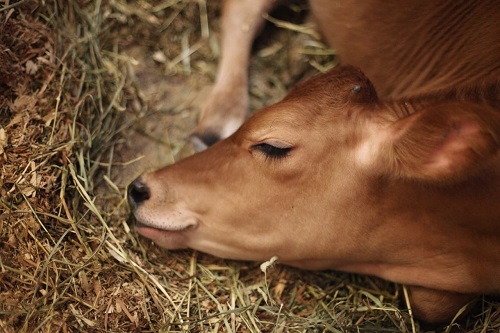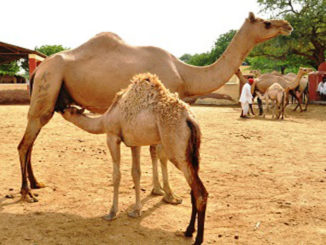Milk fever is a disorder of dairy cows occurring close to calving or within 48-72 hours after calving. It is a metabolic disease caused by a low ionized blood calcium level (Hypocalcaemia). This metabolic condition is also referred to as parturient peresis because of its clinical manifestation involving weak or impaired muscle movement. A shortage of calcium can result in tremors, cows are found in a ‘sitting’ stance, eventual collapse, and potentially death.
Susceptible animals
Commonly found in high yielding dairy cows that are in their 3rd to 5th pregnancy or parturition. Mature and old cows in the age group of 5-10 years or during their 3rd to 7th calving are most commonly affected. Jersey breed of cattle are more prone to this disease while; Indigenous breeds of cattle are commonly resistant to this condition. Cross bred animals are also susceptible to this condition.

Causes of milk fever
Calcium (Ca) requirement increases tenfold upon parturition in dairy cows & buffaloes and its deficiency leads to milk fever (MF). About 80% of cases occur within one day of calving because milk and colostrums production drain calcium (especially ionized Ca) from the blood and some cows are unable to replace the calcium quickly enough. Cows up to the 5th or 6th calving are more prone because they produce more milk leading to depletion of body reserve of ionized calcium. High calcium intake during the dry period tends to increase the incidence of this disease because high calcium depresses the activity of one of the hormone (PTH) which maintains the normal calcium level in the body. In some cows milk fever occurs several days or even weeks before or after calving because of primary calcium deficiency, which is dietary in nature.
Economic Impact
It is important to know the losses to understand the depth of the problem and devise preventive measures. Economic losses due to milk fever are due to (i) expenditure on treatment of affected animals and (ii) reduction in quantity of milk. Yearly economic loss due to MF was estimated to be INR 1000 crores in Haryana alone in recent year. In Tamil Nadu state Veterinarians estimated that the total loss was of Rs 1,069 per cow and Rs 666 per buffalo affected with milk fever. Milk fever can reduce dairy cow’s productive life by 3.4 years as well affect reproductive performance. In addition, each episode of clinical milk fever increases the risk for other parturient diseases such as retained placenta, ketosis, displaced abomasums and environmental mastitis. In US the production loss for cows suffering from milk fever is huge and. The average cost, including medicines, veterinary services, and estimated production loss, amount up to 334 USD per case and total cost because of subclinical milk fever is 4 times higher than the cost of clinical milk fever.
How to Diagnose Milk fever
1. History of Recent parturition.
2. Clinical manifestation of milk fever is experienced in several stages:
Stage-I: It is also called as stage of excitement. There is trembling of the muscle of the hind limb, affected cow become off fed and with less movements, nodding of the head, protrusion of tongue crushing of the teeth and are hyper excited, hind limbs become rigid, loss of control of body movement and fall on the ground.
Stage-II: It is also called as stage of sternal recumbency. Cow and buffaloes rest on sternum, neck or head rest on the flank (“S” shaped posture). Hypersensitivity may disappear but the animal is unable to stand up, muzzle becomes dry and body temperature goes down below normal with muscular weakness and lose of sensation.
Stage-III: It is also called as stage of lateral recumbency. Cows are often unresponsive and almost in an unconscious state. Most animals will die if left untreated in this stage. There is lateral placement of the body with complete flaccidity for which animal cannot stand up, extremely cold skin and body temperature.
3. Laboratory estimation of Calcium level provides a diagnostic insight.
Complications
- Due to lying down for a long time bed sores and bloat are common in large animals.
- There is decrease in urination or no urination due to paresis of muscles.
Treatment
- Replacement therapy: Calcium supplement in the form of calcium borogluconate.
- Supplementation therapy: In addition to calcium supplement, sodium acid phosphate and glucose should be given.
- Corrective therapy: Antihistaminic injection to avoid anaphylactic reaction.
Prevention and Control
- Low calcium diet during last 1-2 weeks of gestation.
- Supplementation of vitamin D3 one week before calving.
- Calcium parenterally soon after calving is effective.
- Exercise helps to maintain normal GI function and stimulate bone metabolism.
- Stress free shelter and comfortable housing.
- Give plenty roughage
- Balanced Dietary Cation-Anion Difference formulations (DCAD) diets with anions chloride and sulphur; and the cations sodium and potassium. This balance can help to maintain blood (and urine) pH. Slightly acidic conditions are needed for the proper mobilisation of bones so that calcium can be released for colostrum and milk production.
| The content of the articles are accurate and true to the best of the author’s knowledge. It is not meant to substitute for diagnosis, prognosis, treatment, prescription, or formal and individualized advice from a veterinary medical professional. Animals exhibiting signs and symptoms of distress should be seen by a veterinarian immediately. |







Be the first to comment